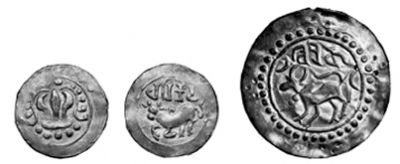Harikela Coins
Harikela Coins mark the reappearance of silver coinage in Bengal after the later-Gupta period and have attracted the attention of scholars since the 1960s. During the second half of the 7th or the first half of the 8th century AD, Noakhali, Comilla and the coastal areas of Chittagong, and a portion of Tripura formed the ancient kingdom of harikela. For example, i-tsing, who visited India between c.673 and 687 AD, has mentioned that he had visited Harikela, situated at the eastern limit of India.
In the beginning this area was ruled by the Khadgas. Later, the Deva dynasty flourished in the region. Another dynasty that had ruled here during c. 8th century AD used the surname of 'Akara'. A series of similar types of coins, read as Lalitakara, Ramyakara, Pradyumnakara, Antakara or Annakara, has been assigned to 10th century AD on paleographic grounds. The large hoard of coins of mainamati and Belonia (Tripura) indicate the existence of a stable economy. However, the second series of Harikela coins is considered to have been issued by the Chandras.

Harikela coins have been found from a number of places in Bangladesh and Tripura. The first known find was from Sylhet where 30-40 specimens were collected, of which 8 are at present preserved in the British Museum. 63 coins from ananda vihara (Mainamati) are preserved in the Indian Museum, Calcutta. From the shalvan vihara, 175 coins were recovered from cell 13 and 52 coins from cell 3. From village Jobra, under hathazari upazila of Chittagong, 28 coins of two denominations have been recovered.
From a hoard found at Belonia, many thin coins were recovered. In addition to Belonia, other find-spots for thin coins are Sylhet and Mainamati. Western scholars call these thin coins 'bractreates'.
The coins of Harikela have been found in various weights and sizes. All of them are round in shape. The earlier coins bear a weight of 64 ratis, which is approximately 7.5 grams. Subsequently, the weight standard was reduced to 60 and 50 ratis. The recorded weight varies from 7.6 to 4.5 grams and the diameter varies from 3.2. to 2.6 cm. From this standard full (7.6g), half (3.8), quarter (1.9g), one-eighth (0.95g) and one-sixteenth (0.45g) denominations of coins are known. The second series, the 'bractreates', which are lighter in weight and thinner, are 2.38 to 3.37 grams in weight and 4.8 to 5.53 cm in diameter. However in rare cases the maximum weight and size respectively can be 4.31 grams and 5.95 cm in diameter. This series might have been influenced by the weight standard as well as the outward appearance of the Abbasid coins.
The silver coins of Harikela were made with high quality silver of about 95.13% fineness, a gold content of 0.59, content of lead 0.38 and copper content of 3.62%. Harikela coins were manufactured from a pre-weighed bead, which were made to coin blanks by flat hammering. The microstructure indicates residual coring from the cast structure converted into parallel bands. Those beads were initially made in a small crucible by melting the required amount of silver according to the standard weight. Perhaps the copper was added prior to this process. The wavy edges in some of the coins clearly indicate that the hammering was carried on an anvil. 'Bractreates', on the other hand, were made from the thin sheets of silver into disks. These disks were further struck with a die after having been placed over a resilient surface like a leather pad. In the beginning two sides were struck by die. But because of their extraordinary thinness, manufacturers soon adopted the system of striking on one side only.
The portrait on the obverse of the coins indicates a recumbent bull to the left, with or without a bell or garland hanging to its neck. The reverse displays a tripartite symbol (Trixula) with garlands hanging from it. On its top are the symbols of the sun and moon. On both sides, the portrait is within a circular border of dots. The legend on the coins is Harikela and is written in the Brahmi script. In smaller coins only Hari appears. In the second series or 'bractreates', Harikela can be clearly read in a few coins. Some times the legend Beraka (this might be Harike) has also been engraved.
Different scholars have read these legend differently. Those readings were Yarikriya, Harikot, Pattikerya, Pattikera, Pattikeda, etc. After comparing them with the inscription of the Arakanese king Anandachandra, visible on a pillar of Shittahung Pagoda, at Mrohaung, Arakan, BN Mukherjee has deciphered the correct legend as 'Harikela'.
No coins of the Pala -Sena rulers of Bengal have yet been found. The Harikela coins indicate the trade contact of Bengal with Arakan. Harikela traders imported silver from Nan-Chao (Yunnan) of Thailand and Bawdwin mines of the Shan State of Myanmar. They, in turn, supplied silver to different areas of North India. The gold coins obtained from the Mainamati excavation indicate that the gold coins of this region have evolved from the debased gold coins of shashanka and other post-Gupta coins of Eastern India, whereas the silver Harikela coins may have developed from an Arakanese prototype. [Pranab K Chattopadhyay]
